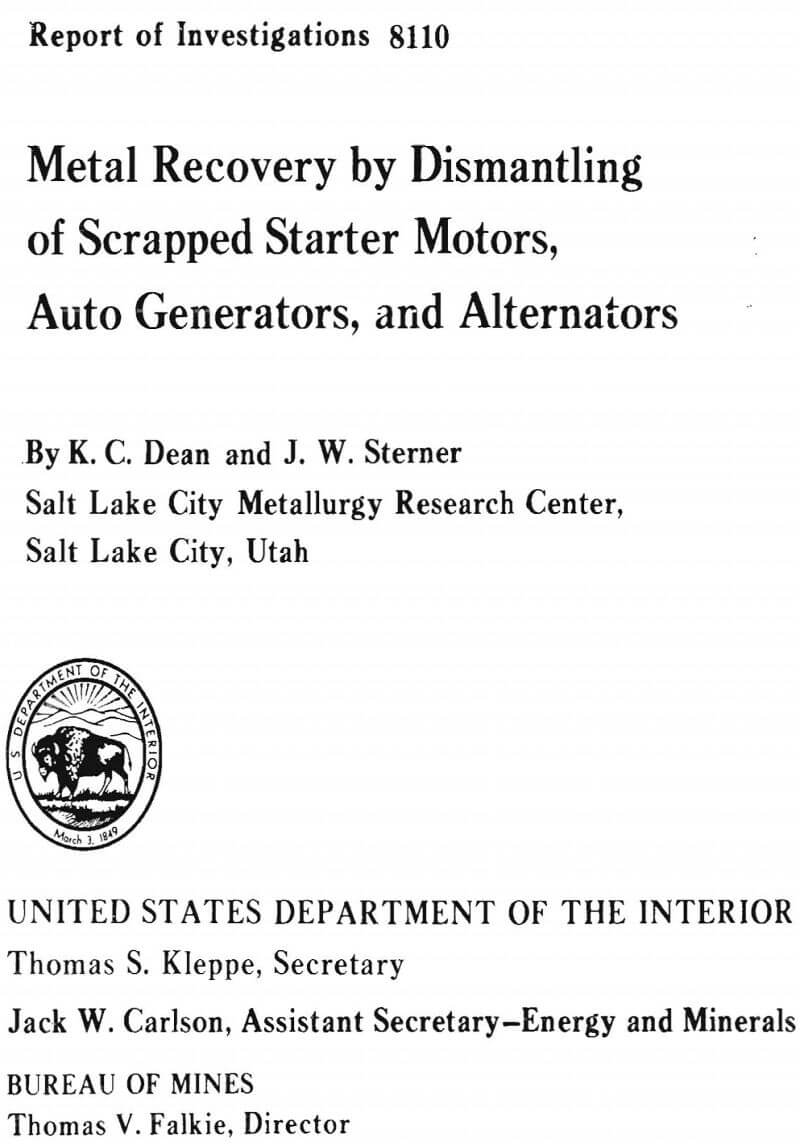Table of Contents
There are two principal methods in use for processing the 8 million cars that are scrapped annually in the United States. About one-half of the cars are processed by shredding in which automobiles minus radiators, batteries, engines, gas tanks, and seats are ripped into fist-sized chunks and then magnetically separated to produce a ferrous scrap fraction and a nonmagnetic fraction. The remaining half of the cars are processed by hand removal of nonferrous, steel, and cast iron parts from the burned or unburned cars, followed by baling or shearing of the stripped hulks. For both methods, the starter and generator (or alternator) are generally removed, although the number of generators still exceeds alternators on scrapped cars, this ratio will shift markedly in a few years because, by 1968, alternators became standard equipment on almost all cars. Currently, the starters, generators, and alternators scrapped annually are estimated to contain 20,000 tons of copper and 130,000 tons of iron. Improved techniques for incineration and dismantling have been reported and are gradually being adopted by scrap processors.
Historically, most of the generators and starters stripped from junked automobiles have either been sold for used parts (with or without rebuilding), treated by chemical dissolution of the copper, or directly smelted for recovery of the copper.
Among the smaller processors, non rebuildable starters and generators have been commonly discarded or given to employees for free time dismantling and sale of the products. Attempts to process starters and generators in shredders followed by magnetic separation of the iron from the nonferrous metals have had indifferent success owing to entanglement of the fragmented components.
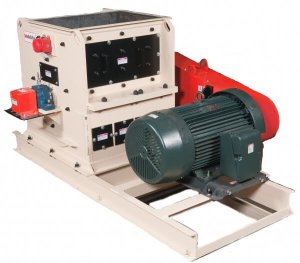
Commercial operations to recover copper as metal and chemicals from generators and starters by leaching have been conducted on a limited basis. Ammonium carbonate solution was used for selectively dissolving the copper. A technique for possibly improving the recovery of the copper from the leach solution by adding sulfur to precipitate copper sulfide was tested in the laboratory by the Bureau of Mines but was not further developed.
A process for selectively melting the copper in a fused-salt bath also was developed by the Bureau, but it has not been adopted commercially. Copper is readily recovered by melting when starters and generators are charged to the converting furnace in a copper smelter, but the accompanying iron is lost in the smelter slag.
This report describes a laboratory study of techniques for dismantling starters, generators, and alternators using hand and power tools in conjunction with small hydraulic presses, power handsaws, and lathes.
Test Materials
The starters, generators, and alternators used in this investigation were obtained from a Utah metal salvage firm. A wide range of types of starters and generators was readily available, while only four types of alternators were used. Both incinerated and unburned units were tested. Starters and generators weigh about 20 to 25 pounds, and alternators weigh about 12 to 15 pounds. Starters, generators, and alternators contain an average of 2.8, 2.6, and 1.5 pounds of copper, respectively. Alternators also contain 3 to 4 pounds of aluminum. Most of the remaining metal is iron. About one-half of the starters have a solenoid that contains 0.5 pounds of copper. Figure 1 is a schematic diagram of a typical starter motor with a solenoid, a generator; and an alternator.
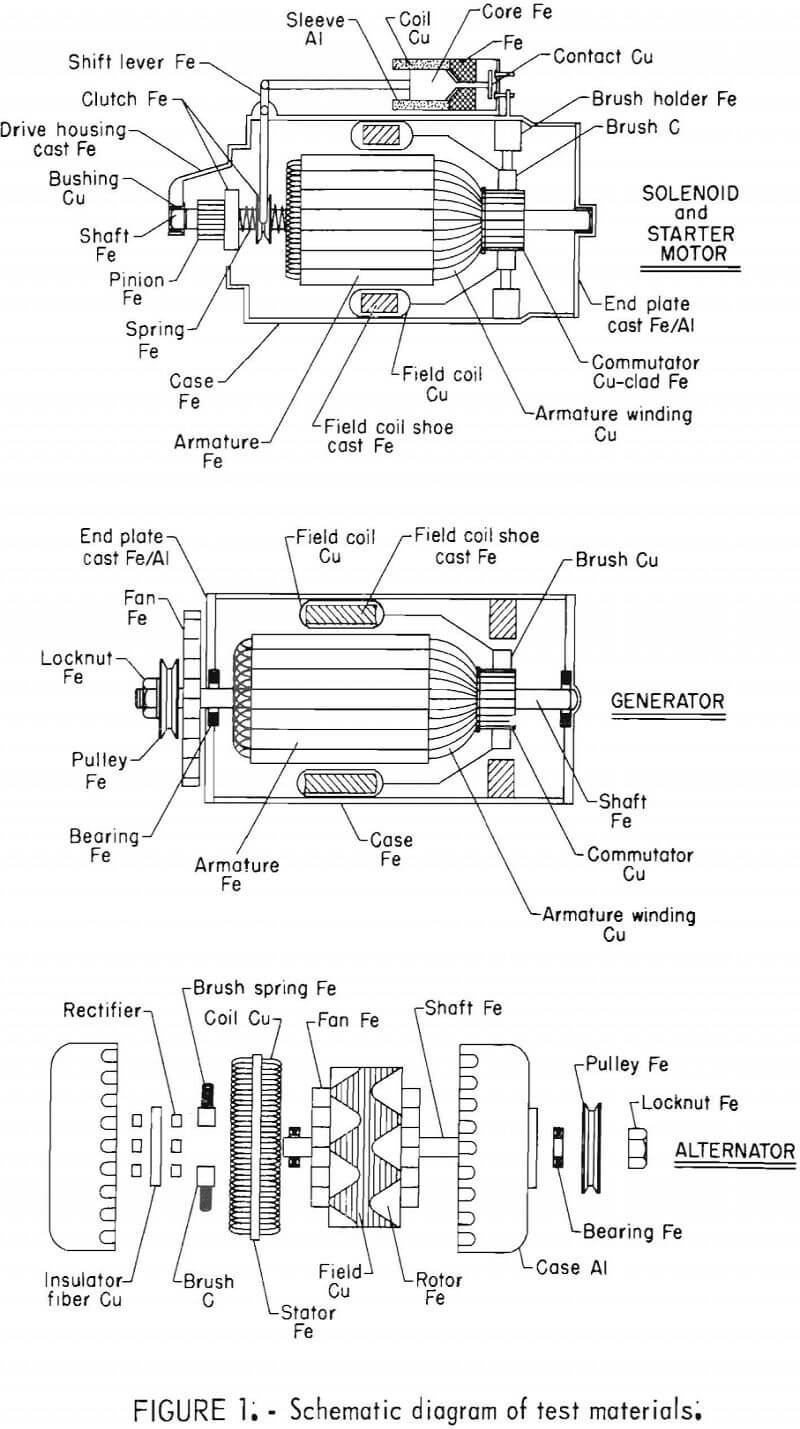
Experimental Work
Time and motion studies were made of the disassembly of test units using hand and power tools, hydraulic presses, power-saws, and lathes to prepare copper, aluminum, and steel products of marketable quality. These studies were made in batch lots of from 15 to 50 generators and starters, and with batch lots of 5 alternators. The dismantling times were averaged to project a working day. The dismantling tools and equipment were arranged in a production line sequence for each group. A few unburned units were incinerated in a laboratory furnace at 600° C. About 30 to 60 minutes of burning time was required to remove grease , oil, or lacquer. A few units were chilled to minus 196° C by immersion in liquid nitrogen to test the effect of chilling on embrittlement prior to crushing. No appreciable embrittlement of the steel encasement was obtained. There were 150 starters, 200 generators, and 15 alternators dismantled during the study. The most effective dismantling techniques are herein described.
Starters
The procedure developed for dismantling a starter was (1) removing the endplate with a speedwrench, (2) press-breaking the cast-iron bendix (pinion-gear) housing to release the armature brushes and bushings, (3) separating the armature from the bendix by cutting the shaft with a bandsaw (about one- fourth of the starters do not require this operation), (4) press-crushing the commutator to loosen the contacts, (5) pressing out the field coils from inside the starter case, (6) cutting the armature wire and field coil wire simultaneously on a lathe using suitable saw fixtures, and (7) collecting the armature and field coil wire.
More than half of the starters have an attached starter solenoid containing a spool of fine copper wire. The procedure used to recover the copper wire was (1) cutting the capsulelike solenoid case lengthwise with a torch and removing the “lid,” (2) melting the inner aluminum spool core using a torch, and (3) recovering the copper spool.
The average time required for one man to dismantle and recover the copper from a typical incinerated starter was 3 minutes; and from a starter solenoid, 1 minute. Dismantling an unincinerated starter required 4 minutes. About 2.8 pounds of copper was recovered from the starter motor and 0.5 pound of copper from the starter solenoid.
Generators
The procedure developed for dismantling a generator was (1) removing the endplate with a speed wrench, (2) separating the armature, brushes, and bushing from the case, (3) pressing out the field coil from inside the case and press-crushing the commutator to loosen the contacts, (4) cutting the armature wire and field coil wire simultaneously on a lathe using suitable saw fixtures, (5) removing the armature wire from the rotor by shaking, and (6) collecting the armature and field coil wires. About 0.1 pound of copper contained in wire, brass fittings, and brushes was collected separately from the main portion of copper wire. The average time required to dismantle and recover the copper wire from an incinerated generator was 2 minutes; and from an unincinerated generator, 3 minutes. About 2.6 pounds of copper was recovered from each generator. Figure 2 shows pressing the commutator to loosen the contacts, while figure 3 shows the completely dismantled generator.
Alternators
Fewer alternators than starters and generators were disassembled. The alternators not only were more difficult to dismantle, but yielded substantially lower metal values. Appreciable improvement may be possible with the following procedure: (1) Removing three or four nuts to free the field coil and allow separation of the aluminum case from the armature, (2) press-removing the shaft and pulley from the armature, (3) cutting the copper-containing field coil away from the starter with a hacksaw, and (4) recovering the copper wire from the armature as described for generators. Dismantling an incinerated alternator required 9 minutes and dismantling an unincinerated
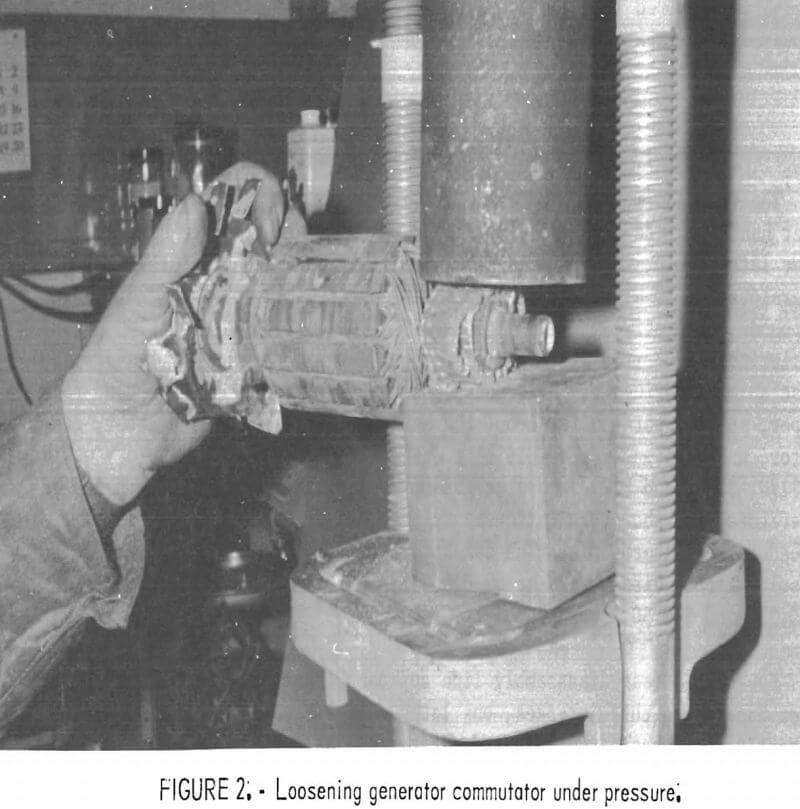
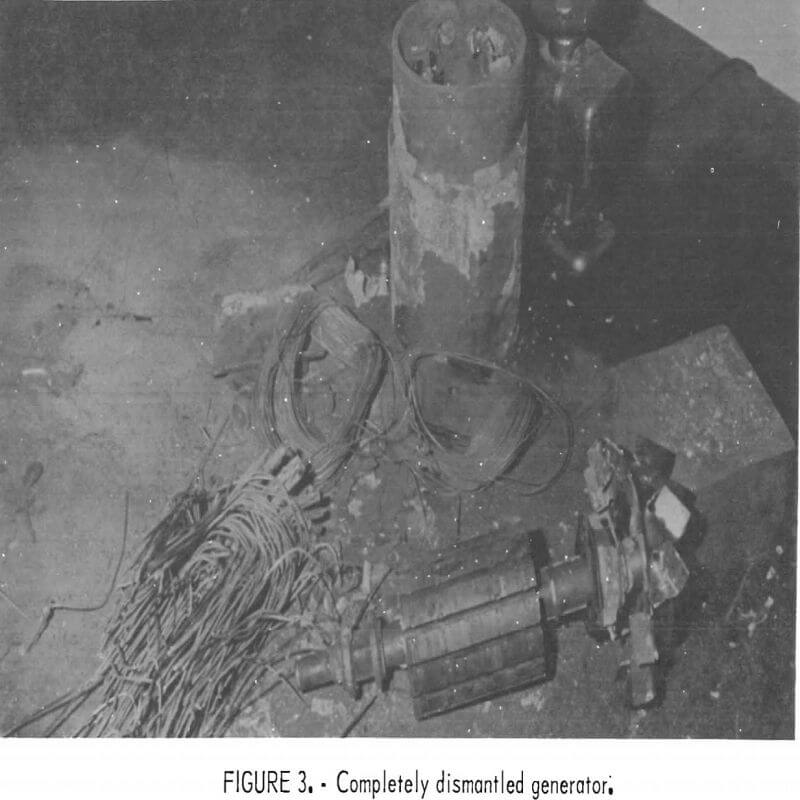
alternator required 10 minutes. Approximately 1.5 pounds of copper was recovered from each alternator.
Dismantling of Starters and Generators
The time and motion studies indicate that an individual equipped with power handtools and conveniently placed hydraulic press, power bandsaw, and power lathe could, in an 8-hour day, dismantle about 100 starters, or 150 generators, or 30 alternators. The scrap copper yield would be 280, 390, and 45 pounds, respectively. The alternators also would yield about 100 pounds of aluminum. The iron yield would be about seven times that of the copper. At scrap metal prices of $0.15 per pound for aluminum, $0.50 per pound for copper, and $30 per ton for iron, the marketable value of the starter, generator, and alternator products that one man could dismantle in a day would be $170, $235, and $42. These values may be attractive for starters and generators, but show that improvements are needed to speed the dismantling procedure for alternators. The same starters, generators, and alternators, if sold without disassembly at $0,035 per pound, would have values of $84.00, $110.25, and $10.50, respectively.
By using a team disassembly line approach, a six-man crew equipped with power handtools, three presses, one lathe, and a bandsaw presumably could dismantle more than six times as many starters as an individual. For dismantling generators, the six-man crew would be equipped with power handtools, one press, and two lathes.
Summary
Time and motion studies showed that scrapped starters and generators can be efficiently disassembled into separately marketable copper and iron components by use of inexpensive hand and power tools, hydraulic presses, handsaws, and power lathes. Substantially improved techniques appear needed for the dismantling of alternators. Local availability of enough scrapped starter motors and generators at a suitable cost may justify a disassembly team approach in processing these items.
